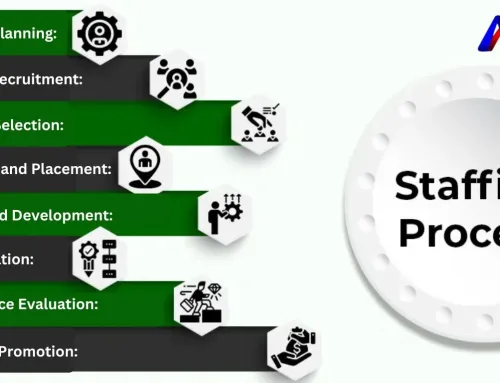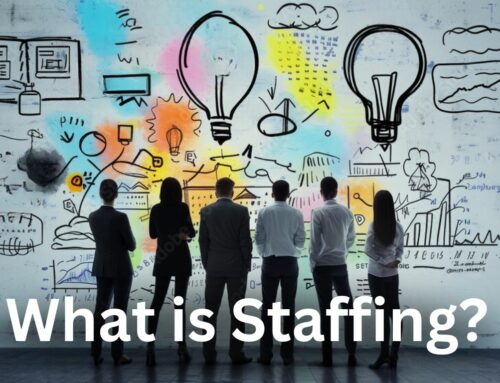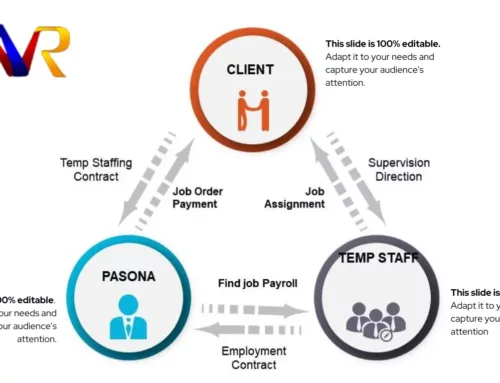Permanent staffing is a critical function within organizations, primarily overseen by the human resources department. This process involves the strategic recruitment and selection of individuals possessing the requisite skills tailored for specific roles within the company or particular projects. The significance of staffing cannot be overstated, as the careful inclusion of well-suited candidates contributes to organizational progress, while the presence of ill-fitted individuals may hinder workflow and project execution. The diversity of staffing types is shaped by various factors, including an organization’s goals, objectives, market dynamics, industry requirements, and strategic workforce planning. Consequently, the selection of a particular staffing approach is influenced by the unique characteristics, purpose, and goals of an organization.
Interested in Our services
Understanding the Dynamics of Staffing Types
The diversity of staffing types is a direct reflection of an organization’s goals, objectives, market conditions, industry needs, and strategic workforce planning. The selection of a specific staffing approach becomes a nuanced decision, guided by the unique characteristics, purpose, and goals of the organization. It is a dance between organizational identity and the evolving demands of the business landscape.
Permanent staffing stands out as a pivotal force that shapes an organization’s long-term trajectory. Unlike its counterparts, such as temporary staffing and contract staffing, which address short-term needs or specific projects, permanent staffing involves the strategic hiring of individuals who not only contribute to enduring goals but also become integral long term components of the organizational fabric.
In contrast, temporary staffing is often utilized to meet transient projects in workload or cover for absent employees. The employment relationship is tied to the duration of increased demand, and job security is inherently lesser. Non-permanent contract staffing specifies a definite period during which the employee is engaged. Once the contract expires or the project is completed, the employment relationship ends unless renewed.
Permanent Staffing: A Meticulous Art and Strategy
The permanent staffing process demands a meticulous recruitment process, as the selected candidates transcend the role of mere employees to become genuine ambassadors shaping the company’s lasting identity. In contrast to the often quicker and more flexible temporary and contractual staffing, permanent staffing involves extensive screening, ensuring a careful match between candidate and organization.
The process of permanent staffing is comprehensive and involves multiple steps to guarantee the selection of candidates who not only possess the requisite qualifications but also align with the organization’s goals and culture. Advertising jobs with detailed descriptions, conducting multiple rounds of interviews, skills assessments, and reference checks are integral components of this process.
Benefits and Investment in Permanent Staffing
Permanent employees enjoy a comprehensive package of benefits, including health insurance, retirement plans, paid time off, and other perks. Companies recognize the importance of investing in the training and development of permanent staff to enhance their skills, keep them updated on industry trends, and support their long-term career growth within the organization. This strategic investment contributes to building a skilled and knowledgeable workforce, aligning with the organization’s objectives.
The permanence of employment in permanent staffing implies higher job security compared to contract workers, reinforcing the commitment of these individuals to the organization. This commitment extends beyond job security and becomes an integral part of the organizational culture, fostering loyalty and
dedication.
Exploring the Types of Permanent Staffing
In the intricate world of talent acquisition, organizations deploy a diverse range of strategies to build a robust and enduring workforce. Permanent staffing, a cornerstone of organizational success, encompasses an array of hiring approaches designed to meet the unique needs and goals of each company. Let’s delve into the diverse landscape of permanent staffing methodologies and how they contribute to shaping a thriving organizational culture.
Direct Hire or Full-Time Employment:
In this time-honored approach, organizations directly hire candidates for permanent positions, laying the foundation for enduring employment relationships. This traditional form ensures a direct alignment of skills and qualifications with organizational needs.
Regular Full-Time Employment:
Employees engaged in regular full-time positions dedicate standard hours to their roles, reaping the benefits of comprehensive packages, including health insurance and retirement plans. This approach provides stability and a sense of belonging.
Regular Part-Time Employment:
Tailored for flexibility, regular part-time employment allows individuals to contribute meaningfully while enjoying pro-rated benefits. This accommodates both organizational needs and individual work-life balance.
Permanent Contractual Employment:
Striking a balance between permanence and flexibility, this approach involves hiring employees on a permanent basis but with specific terms outlined in their contracts. It provides adaptability for both employers and employees.
Internal Promotions:
Recognizing and nurturing talent within, organizations opt for internal promotions to fill permanent positions. This approach emphasizes career growth, development, and the retention of dedicated personnel.
Employee Referral Hires:
Harnessing the power of internal networks, organizations encourage employees to refer qualified candidates. This not only streamlines the hiring process but also fosters a cultural fit within the workforce.
Recruitment Agencies or Headhunters:
External expertise comes into play as organizations engage recruitment agencies or headhunters. This approach leverages industry insights and networks to secure top-notch talent, to identify and place qualified candidates. We, at MNR Solutions, stand as an eminent international staffing agency, align businesses with the expertise to fit their unique requirements, by acting as a gateway to top-notch international jobs through our extensive and thorough expert screening and recruitment process.
Campus Recruitment:
Building for the future, companies tap into educational institutions to recruit fresh graduates for permanent positions. This fosters a pipeline of young, talented individuals entering the workforce.
Executive Search or C-Suite Hiring:
For top-tier leadership positions, organizations enlist executive search firms to identify and recruit high-level executives. This ensures a meticulous selection process for crucial roles.
Skill-Based Hiring:
Focused on strategic skill acquisition, organizations opt for skill-based hiring to ensure that specific competencies crucial for the company’s success are present in the workforce.
Diversity Hiring:
Recognizing the strength in diversity, companies actively seek candidates from various backgrounds. This promotes inclusion and contributes to a vibrant and innovative organizational culture.
Global or International Hiring:
Catering to the demands of a globalized world, organizations engage in international hiring, considering local factors and regulations. This approach ensures a diverse and culturally aware workforce.
Employee Retention Programs:
Beyond recruitment, organizations invest in retaining and engaging existing employees for the long term. Retention programs contribute to job satisfaction and loyalty.
Succession Planning:
Forward-thinking organizations identify and groom employees for key positions in the future through succession planning. This ensures a seamless transition in leadership and critical roles.
The Staffing Process: Navigating Each Step
The major steps involved in recruiting permanent staff are crucial in ensuring the success of the process. It begins with clearly setting up the job description, providing a detailed account of the job role, responsibilities, qualifications, specific skills, and experiences required for success in the role. Developing a comprehensive job description communicates the key responsibilities, qualifications, and expectations for the position, highlighting the company’s values, culture, and opportunities for career growth.
Internal or external recruitment is a decision-making process that companies undertake during permanent recruiting. Choosing between promoting a position internally, leveraging employee referrals, or employing external recruitment methods like job boards, industry-specific websites, or recruitment agencies is a critical aspect of the permanent recruiting process. Each approach has its advantages and considerations, and the choice depends on factors such as the organization’s culture, the urgency of the hiring need, and the specific skills required for the position.
Application screening is a pivotal step in the permanent staffing process. It involves evaluating incoming applications and resumes to identify candidates who meet specified criteria. This includes the initial assessment of resumes, cover letters, and other application materials. The goal is to shortlist candidates whose qualifications align with the position’s requirements, thereby refining the candidate pool for further evaluation.
The interview process is a crucial aspect of permanent staffing. It entails conducting interviews to assess candidates’ skills, experience, and cultural fit within the organization. This may involve multiple rounds with different stakeholders, ensuring a comprehensive evaluation of the candidate’s suitability for the role and alignment with the organizational culture.
Technical and skill assessment is particularly relevant for the positions that require specific technical or industry-related skills. This step involves conducting assessments, which could include written tests, case studies, or practical exercises, to evaluate candidates’ capabilities in these specialized areas.
Reference checks are an integral part of the permanent staffing process. Contacting the references provided by candidates helps verify their work history, skills, and qualifications, ensuring the accuracy of the information provided during the recruitment process.
Background checks are a crucial step in upholding the integrity of the hiring process. This involves verifying education credentials, employment history, and any criminal records, providing a comprehensive overview of the candidate’s background and suitability for the position.
The job offer is a formal step in the permanent staffing process. It includes extending a formal job offer to the selected candidate, outlining details such as salary, benefits, start date, and terms of employment. This stage marks the culmination of the evaluation process and the decision to bring the candidate into the organization.
Negotiation and finalization may be necessary, depending on the specific circumstances. Companies may engage in negotiations with the selected candidate regarding salary, benefits, or other terms before finalizing the employment agreement.
Onboarding is a critical step in integrating new employees into the organization. This involves guiding the onboarding process, which includes orientation, training, and introducing the new employee to the company’s culture, policies, and procedures.
Ongoing support and development are crucial for the long-term success of permanent employees. Providing continuous support ensures that the new employee has the necessary resources and training for their role, contributing to their satisfaction and maximum work efficiency. Strategies for career development within the organization further enhance the employee’s growth and commitment.
Performance evaluation is an ongoing process that involves establishing a system for regular performance evaluations. This allows for the assessment of the employee’s progress, providing feedback, and identifying opportunities for further development. Regular evaluations contribute to a culture of continuous improvement and help align individual performance with organizational goals.
Conclusion
In conclusion, navigating the landscape of permanent staffing is a multifaceted endeavor, requiring a careful balance of strategy, foresight, and adaptability. A structured and comprehensive permanent staffing process is essential for organizations to attract and retain the right talent, contributing to their sustained growth and success in the dynamic business landscape.
In a globally connected job market, the quest for the right talent often poses challenges for businesses. MNR Solutions stands as an eminent international staffing agency, catering to this need with a comprehensive suite of services. Their expertise spans from candidate sourcing to strategic talent acquisition, navigating the complexities of global recruitment effortlessly. By leveraging industry insights and a vast network, they align businesses with the expertise that fits their unique requirements, enabling clients to thrive in a competitive landscape.
MNR Solutions prioritizes local management and a profound grasp of the global business scenario. This approach bridges cultural gaps, providing businezsses access to a diverse talent pool. Despite the hurdles like visa requirements and employment contracts, partnering with MNR Solutions streamlines the international recruitment process efficiently.




